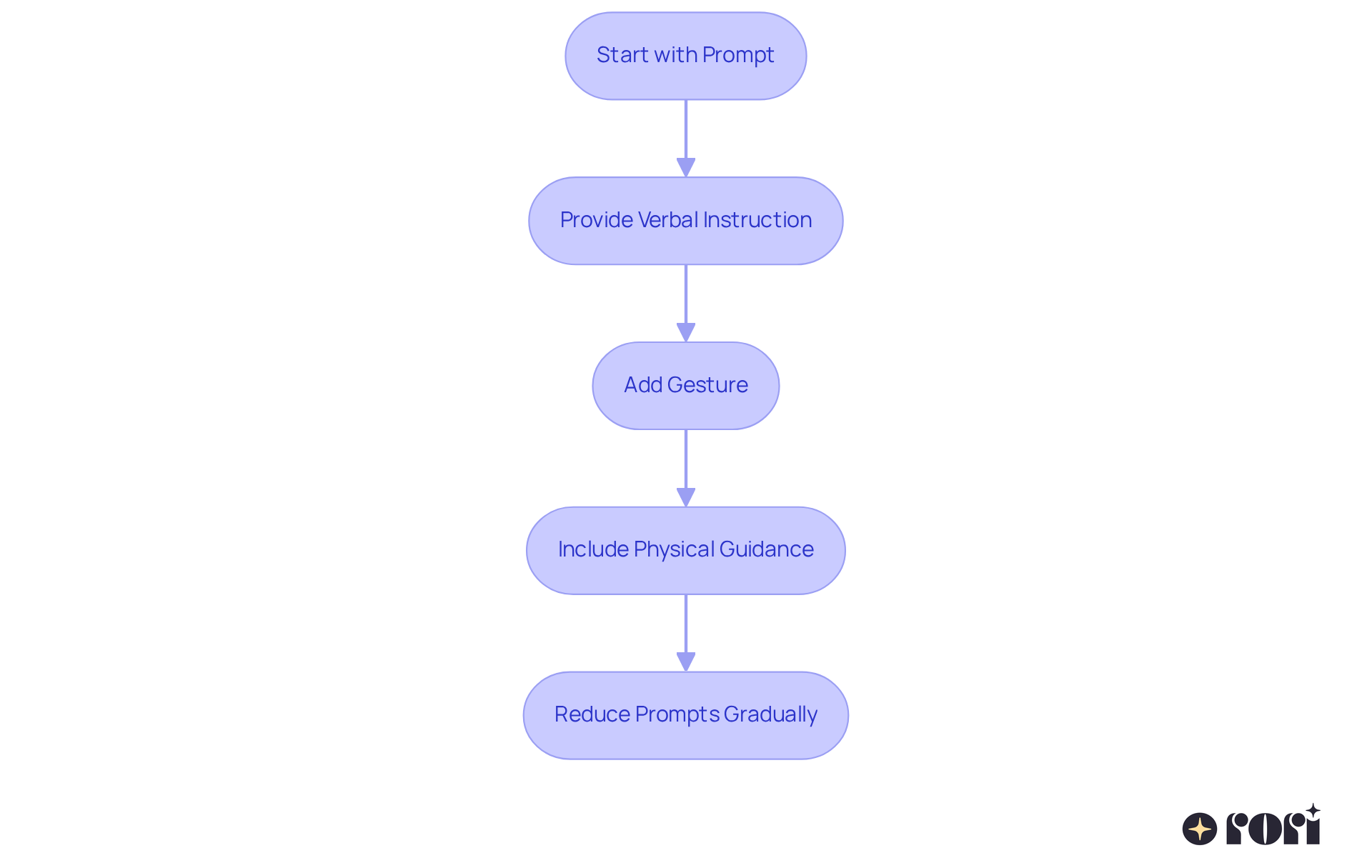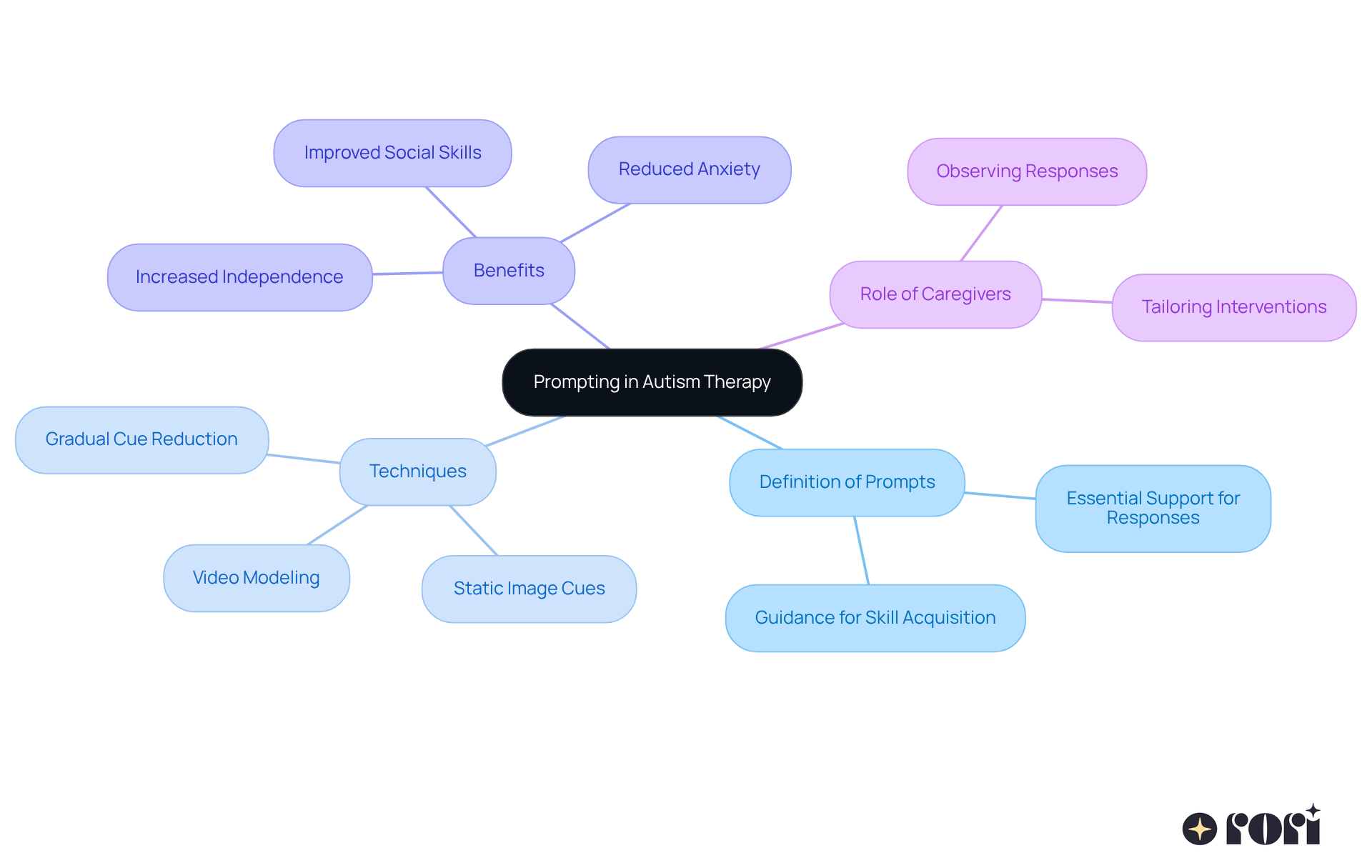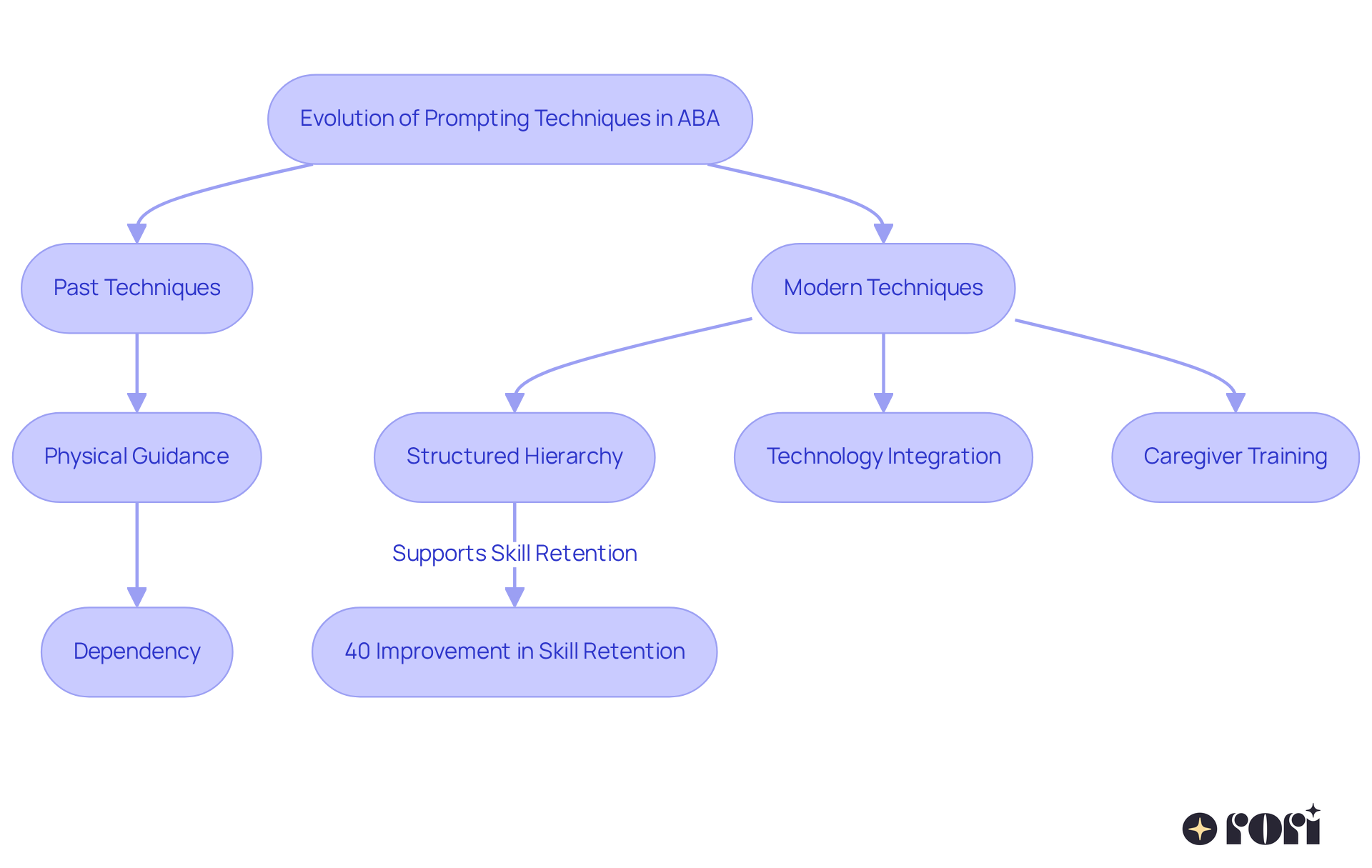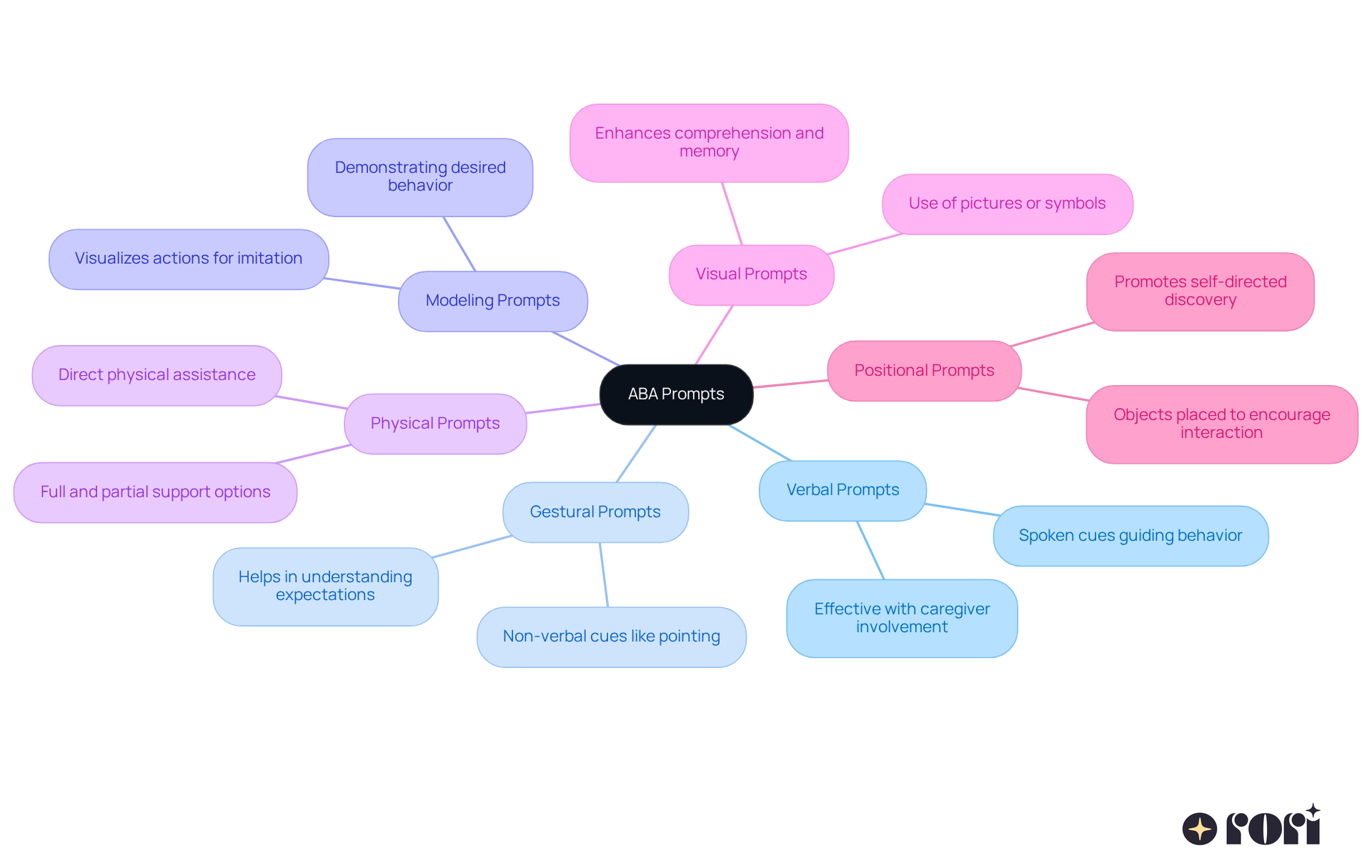This article dives into the role of prompting in Applied Behavior Analysis (ABA) therapy, highlighting its significance in helping children, especially those with autism, acquire new skills. It discusses the different types of prompts—like verbal, gestural, and visual—that are used to guide learning. You’ll see how effective prompting, paired with active involvement from caregivers, can really boost learning outcomes and foster independence in young individuals.
Isn’t it amazing how something as simple as a prompt can make such a difference? By understanding the various ways prompts can be used, caregivers can create a supportive learning environment that encourages children to thrive. So, let’s explore this together and see how we can enhance the learning journey for our little ones!
Navigating your child's developmental journey can be quite a challenge, especially when it comes to understanding the intricacies of prompting in Applied Behavior Analysis (ABA) therapy. But don't worry! By using various cues—like verbal, gestural, or visual—therapists can really enhance learning outcomes for children with autism, helping them build independence and confidence along the way.
As these techniques evolve, it’s natural to wonder: how can you, as a caregiver, effectively engage in this process? Your involvement is key to ensuring your child's success and growth. Let’s explore this together and see how you can make a difference in your child's life!
The prompt definition aba involves using cues or assistance in Applied Behavior Analysis (ABA) therapy to help someone respond in a specific way. Think of it like a gentle nudge! These prompts can be verbal instructions, gestures, or even a bit of physical guidance, all designed to make learning easier and help young people move toward the right behavior until they can do it on their own. For example, a therapist might say, 'Pick up your spoon,' while pointing to it, helping the child understand what to do.
This method, rooted in prompt definition aba, is especially important for individuals with autism, as it significantly boosts their ability to learn new skills and behaviors. Research shows that structured prompting methods, like least-to-most prompting, can lead to mastery rates that are 25% faster than other approaches. By gradually reducing the cues, young learners not only gain the ability to perform tasks independently but also build confidence in their skills.
Using these techniques effectively is key! They provide a clear path for kids to move from relying on prompts to functioning on their own, ultimately improving their learning outcomes. And here’s something encouraging: progress is seen in 90% of children when the recommended hours are fully utilized with active caregiver involvement. This highlights just how vital caregiver participation is in the ABA process.
Additionally, early intensive behavioral intervention (EIBI) plays a crucial role in enhancing learning, verbal, and social skills for kids with autism. So, you see, the techniques related to the prompt definition aba are an essential part of their developmental journey. Let’s explore this together and see how we can support our children every step of the way!

Isn’t it true that prompt definition aba is such an important part of autism therapy? It’s crucial for the prompt definition aba in teaching new skills and reinforcing those desired behaviors. It provides young individuals with the essential support they need to respond correctly to various stimuli, greatly enhancing their educational experiences. For example, when teaching greetings, a therapist might say something like 'Say hello' or even use a gesture like waving. This kind of guidance not only serves as a prompt definition aba for the individual to understand the right responses but also builds their confidence in social situations.
Research shows that cueing techniques can lead to significant improvements in social skills among children with autism. One study found that both video modeling and static image cues were effective in boosting independence in daily living skills, highlighting how adaptable these cues can be across different contexts. By gradually reducing the cues, therapists encourage children to tackle tasks on their own, promoting self-reliance and mastery of skills.
Clinicians often emphasize how the prompt definition aba of transformative cues can be in the learning process. One expert noted that clear and concise requests can really help reduce anxiety and support learning, creating a comfortable environment for engagement. Plus, data indicates that effective prompting, as described in the prompt definition aba, can enhance greetings and social interactions—vital skills for building relationships and navigating social settings.
Caregivers play a key role in this journey by actively observing their child’s responses to cues. This helps in tailoring interventions for better effectiveness. For instance, caregivers can track how often their child responds accurately to prompts in different situations, allowing for adjustments in strategies as needed.
Overall, using cues strategically not only aids in skill development but also plays a vital role in nurturing social abilities, helping individuals with autism thrive in various settings. At Rori Care, our clinical leadership team is wholeheartedly dedicated to supporting families and fostering child development with expertise and compassion. Let’s explore this together!

The methods of cueing in ABA therapy have come a long way since the field began. In the past, many approaches relied heavily on physical guidance, which sometimes led to dependency instead of fostering independence. As our understanding of behavior analysis has grown, practitioners have recognized the importance of reducing cues to encourage independence.
Today, modern techniques use a structured hierarchy that ranges from the least to the most intrusive methods. This allows therapists to customize their approach based on each child's unique needs and preferences. This evolution reflects a broader shift towards ethical and effective practices in ABA therapy, highlighting the prompt definition aba by focusing on empowering children and enhancing their skills instead of relying on external prompts.
Recent trends are also highlighting the integration of technology-enhanced support systems. These systems not only boost efficiency but also help with automatic data collection, ensuring that progress is measured consistently. In fact, programs that include automatic data collection show a 40% improvement in the retention of learned skills compared to those that don't have systematic measurement. Isn't that impressive?
All data collected during sessions is kept secure, anonymized, and deleted after analysis, which protects privacy while enhancing the therapeutic experience. Plus, caregiver training is crucial in building skills at home, helping to extend the benefits of therapy beyond the session. By equipping caregivers with ABA principles and strategies, they can actively support their children's behavioral goals, leading to better outcomes and informed decisions.
As Dr. Kadriye El-Atwani points out, these strategies not only enhance skill acquisition but also promote educational equity for multilingual learners. This truly reflects a commitment to individualized and ethical practices in ABA therapy. Let’s explore this together and see how we can make a difference!

The prompt definition aba indicates that ABA cues are essential tools in the learning process, and they come in several key types, each serving a distinct purpose. Let's break them down together:
Verbal Prompts: These are spoken cues that guide the child toward the desired behavior, like telling them to 'pick up the toy.' Research shows that verbal cues can significantly improve a young person's ability to follow directions, especially when caregivers are involved in the therapeutic process. In fact, progress is seen in 90% of youths when caregivers participate in the recommended therapy hours. This highlights just how crucial caregiver engagement is for the success of ABA strategies.
Gestural Prompts: These are non-verbal cues, such as pointing or nodding, that indicate the expected action. They help young learners understand what is expected of them without overwhelming them with too many words.
Modeling Prompts: This involves demonstrating the desired behavior for the child to imitate, like showing them how to tie their shoes. It’s a fantastic approach because it allows young learners to visualize the action before they try it themselves.
Physical Prompts: Here, we provide direct physical assistance, such as guiding the child’s hand to complete a task. Full physical cues offer complete support, while partial cues give just enough help to encourage independence.
Visual Prompts: These use pictures or symbols to represent actions or behaviors, making it easier for children to understand. Visual cues have been shown to enhance comprehension and memory, especially for individuals with autism, by turning abstract ideas into something tangible.
Positional Prompts: This involves placing objects in specific locations to encourage interaction, like putting a toy within reach. It helps young individuals engage with their environment and promotes self-directed discovery.
Each type of prompt definition aba is designed to enhance learning while gradually encouraging independence. This means that, ultimately, children can carry out tasks on their own. When techniques for encouragement are tailored to each child's unique needs, the results can be remarkable. Studies indicate that 90% of individuals achieve significant progress when their caregivers are actively involved in the ABA therapy process.
Additionally, caregiver education is vital. It equips caregivers with the knowledge and skills they need to effectively support their child's development. As Dube wisely notes, "Ultimately, the aim of encouraging is to foster independence in learners."
Moreover, timely fading is a key element of ABA therapy. Therapists gradually reduce the level of assistance to promote independent performance. Collecting data on prompting responses is fundamental to ABA, guiding programming decisions and ensuring interventions remain relevant and beneficial. By addressing potential prompt dependency through systematic fading, therapists can help learners achieve lasting independence. This approach not only supports the child's development but also empowers caregivers to make informed decisions that positively impact their child's progress.
Let’s explore this together! Remember, you’re not alone in this journey.

Understanding the role of prompting in ABA therapy is so important for parents looking to support their children with autism. Prompting acts like a guiding hand, giving the necessary cues and assistance that help kids learn and develop independent skills. By using effective prompting techniques, caregivers can really boost their child's ability to respond appropriately in different situations, ultimately nurturing a sense of autonomy and confidence.
Throughout this article, we’ve shared some key insights about the types of prompts used in ABA therapy, like verbal, gestural, modeling, physical, visual, and positional prompts. Each type has its own special purpose in helping children learn and master new behaviors. We also highlighted the importance of caregiver involvement, showing how being actively engaged in the therapeutic process can lead to amazing progress. Plus, the evolution of prompting techniques reflects a growing understanding of the need for personalized approaches that prioritize the child's independence and learning outcomes.
In conclusion, embracing the principles of prompting in ABA therapy is essential for nurturing the skills and confidence of children with autism. By teaming up with therapists and actively participating in their child's learning journey, parents can create a supportive environment that encourages growth and independence. This commitment not only benefits the child but also deepens the understanding of their unique needs, paving the way for a brighter future. Let’s explore this together! We’re here to help you every step of the way!
What is prompting in ABA therapy?
Prompting in ABA therapy involves using cues or assistance to help someone respond in a specific way. This can include verbal instructions, gestures, or physical guidance to facilitate learning and encourage the right behavior.
Why is prompting important for individuals with autism?
Prompting is especially important for individuals with autism as it enhances their ability to learn new skills and behaviors. It provides structured support that can lead to faster mastery of tasks.
What is least-to-most prompting?
Least-to-most prompting is a structured prompting method that gradually reduces the level of assistance provided, allowing learners to gain independence and build confidence in their skills.
How effective is prompting in improving learning outcomes?
Research shows that structured prompting methods can lead to mastery rates that are 25% faster than other approaches, significantly improving learning outcomes for children.
What role do caregivers play in the ABA process?
Caregiver participation is vital in the ABA process, as progress is seen in 90% of children when caregivers are actively involved and the recommended hours of therapy are utilized.
What is early intensive behavioral intervention (EIBI)?
Early intensive behavioral intervention (EIBI) is a method that enhances learning, verbal, and social skills for children with autism, playing a crucial role in their developmental journey.